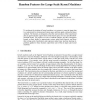NIPS
2007
14 years 1 months ago
2007
NIPS
2007
14 years 1 months ago
2007
To accelerate the training of kernel machines, we propose to map the input data to a randomized low-dimensional feature space and then apply existing fast linear methods. The feat...
NIPS
2007
14 years 1 months ago
2007
Assessing similarity between features is a key step in object recognition and scene categorization tasks. We argue that knowledge on the distribution of distances generated by sim...
NIPS
2007
14 years 1 months ago
2007
Reward-modulated spike-timing-dependent plasticity (STDP) has recently emerged as a candidate for a learning rule that could explain how local learning rules at single synapses su...
NIPS
2007
14 years 1 months ago
2007
In recent years, the language model Latent Dirichlet Allocation (LDA), which clusters co-occurring words into topics, has been widely applied in the computer vision field. Howeve...
NIPS
2007
14 years 1 months ago
2007
Rosetta is one of the leading algorithms for protein structure prediction today. It is a Monte Carlo energy minimization method requiring many random restarts to find structures ...
NIPS
2007
14 years 1 months ago
2007
Statistical models on full and partial rankings of n items are often of limited practical use for large n due to computational consideration. We explore the use of non-parametric ...
NIPS
2007
14 years 1 months ago
2007
This paper investigates the application of randomized algorithms for large scale SVM learning. The key contribution of the paper is to show that, by using ideas random projections...
NIPS
2007
14 years 1 months ago
2007
Rare category detection is an open challenge for active learning, especially in the de-novo case (no labeled examples), but of significant practical importance for data mining - ...
NIPS
2007
14 years 1 months ago
2007

